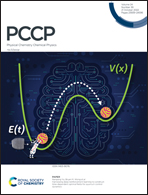Effects of p–d orbital mixings on magnetocrystalline anisotropy for D3d-symmetric ferromagnetic semiconducting monolayers†
Abstract
Understanding magnetic anisotropy based on electronic properties is vital for theoretical and applied research on ferromagnetic semiconductors. Here, for several representative D3d-symmetric ferromagnetic semiconducting monolayers, we investigate the effects of mixings between d-orbitals of central magnetic atoms and p-orbitals of ligands on magnetocrystalline anisotropy energy (MAE). For high-spin materials, the weakening of p–d mixing increases the electron occupation of spin-up bonding d-orbitals at the expense of the electron occupation in the corresponding spin-down orbitals, In contrast, the weakening of p–d mixing decreases the electron occupation of the spin-up antibonding d-orbitals and enhances the electron occupation in the corresponding spin-down orbitals. The weakening mixings also result in an overall shift of the spin-down band toward a higher energy with respect to the spin-up band. These changes are just the opposite in a low-spin material. More interestingly, we find that the transition point between the bonding and the antibonding spin-up bands plays a significant role in tuning the MAE. Its shift with strain is almost linearly related to the p–d bond strength and significantly affects both the electron occupation of occupied spin-up antibonding d-bands and the band shift of unoccupied spin-up d-bands. Furthermore, the correlation of these mixing-related changes in electronic structures with the MAE is qualitatively and quantitatively analyzed. Our findings can deepen the understanding of the correlation between MAE and p–d orbital mixings and provide theoretical guidance for modulating the MAE.



 Please wait while we load your content...
Please wait while we load your content...